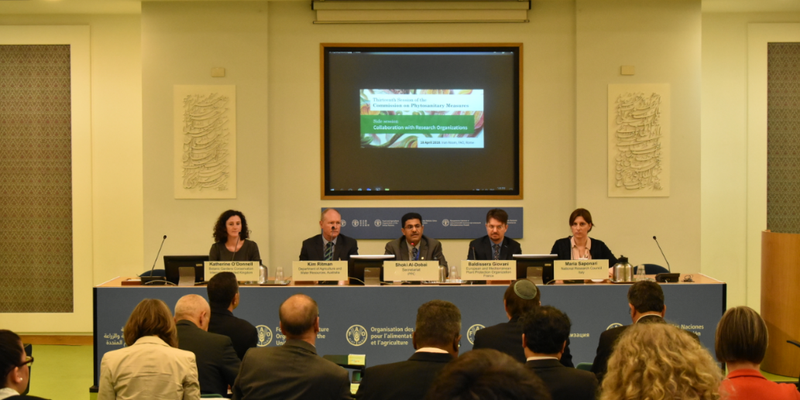CPM-13 Side session on Collaboration with Research Organizations held at FAO HQs
Posted on Fri, 20 Apr 2018, 15:27

Shoki Al-Dobai, Integration and Support Team Leader in the IPPC Secretariat, welcomed participants to the CPM-13 side session on Collaboration with research organizations and recalled the TC-RPPO in 2016 in Morocco, which proposed to hold this important side session. In his opening remarks, Dr. Al-Dobai stated: We are in dire need of collaborating with research organizations and academia to support global plant health efforts by the IPPC community.
Dr. Kim Ritman, Australia s Chief Plant Protection Officer efficient use of resources for wider adoption of results. Why are we collaborating? For many reasons, including higher quality of science, greater efficiency in resources, opportunities for rapid action to reduce the international spread and impact of pests (e.g. for Xylella fastidiosa), and fosters innovation. With this in mind, he proposed to include research and collaboration within the IPPC Strategic Framework for 2020-2030. How do we collaborate? By setting common goals and mutual interests, aided by strong leadership, open relationships, and collaboration platforms, among others, he added. He provided examples of positive outcomes of this collaboration, including work undertaken by the International Forest Quarantine Research Group, which helped implementing ISPM-15, ACIAR, and Euphresco.
Dr. Baldissera Giovani of the European and Mediterranean Plant Protection Organization (EPPO), said: Without phytosanitary research, NPPOs would not be able to perform their duties. He informed that Euphresco s aim is to develop a European Research area in more than 70 countries. Is a platform for research to serve policy and also for policy to shape research, he said. Dr. Giovani also presented a series of Euphresco projects, including the PRACTIBAR project on genetic bar-coding and the planned project on the elimination of Xylella fastidiosa in planting material using hot water steam treatment. He concluded that collaboration serves all, because threats are increasing, while resources are decreasing, and different countries face similar phytosanitary risks and problems.
Dr. Katherine O Donnell, Head of Seed Conservation and Plant Health at Botanic Gardens Conservation International, a network of over 3,000 botanic gardens worldwide, also addressed the numerous public in attendance. She presented the activities of the International Plant Sentinel Network (IPSN), which provides an early warning system to recognize new and emerging pest risks. She informed that there are plants growing outside their native range in botanic gardens worldwide, and these plants can be monitored for damage by pests and diseases. The second phase of IPSN encompasses sixteen partners which represent a global network of plant health institutes, NPPOs and botanic gardens, she added. Botanic gardens are provided with survey materials and guidance called IPSN Plant Checker.
Dr. Maria Saponari of the Institute for Sustainable Plant Protection, CNR at Bari, Italy, presented a concrete example of collaboration in the field of plant health: the harmonized protocols for monitoring and detection of Xylella fastidiosa in its host plants and its vectors. The goal of the project is to enhance scientific knowledge to support the development of EU harmonized sampling and diagnostic procedures, for effective identifications of Xylella fastidiosa in its host plants and vectors. The outcomes of the project were the development of effective tools for survey, monitoring and control in supporting regional and national plant protection organizations. She recalled that Xylella fastidiosa is a very complex pest, as it can infect a very large number of host, and plant materials for testing can be not easy to collect as Xylella fastidiosa is a quarantine pest. She concluded that training courses were conducted to improve capacity of inspectors and laboratories in affected countries.

Watch the recording of this side session at the following link: http://www.fao.org/webcast/home/en/item/4672/icode/

